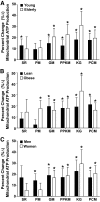Age, obesity, and sex effects on insulin sensitivity and skeletal muscle mitochondrial function
- PMID: 19833885
- PMCID: PMC2797949
- DOI: 10.2337/db09-0591
Age, obesity, and sex effects on insulin sensitivity and skeletal muscle mitochondrial function
Abstract
Objective: Reductions in insulin sensitivity in conjunction with muscle mitochondrial dysfunction have been reported to occur in many conditions including aging. The objective was to determine whether insulin resistance and mitochondrial dysfunction are directly related to chronological age or are related to age-related changes in body composition.
Research design and methods: Twelve young lean, 12 young obese, 12 elderly lean, and 12 elderly obese sedentary adults were studied. Insulin sensitivity was measured by a hyperinsulinemic-euglycemic clamp, and skeletal muscle mitochondrial ATP production rates (MAPRs) were measured in freshly isolated mitochondria obtained from vastus lateralis biopsy samples using the luciferase reaction.
Results: Obese participants, independent of age, had reduced insulin sensitivity based on lower rates of glucose infusion during a hyperinsulinemic-euglycemic clamp. In contrast, age had no independent effect on insulin sensitivity. However, the elderly participants had lower muscle MAPRs than the young participants, independent of obesity. Elderly participants also had higher levels inflammatory cytokines and total adiponectin. In addition, higher muscle MAPRs were also noted in men than in women, whereas glucose infusion rates were higher in women.
Conclusions: The results demonstrate that age-related reductions in insulin sensitivity are likely due to an age-related increase in adiposity rather than a consequence of advanced chronological age. The results also indicate that an age-related decrease in muscle mitochondrial function is neither related to adiposity nor insulin sensitivity. Of interest, a higher mitochondrial ATP production capacity was noted in the men, whereas the women were more insulin sensitive, demonstrating further dissociation between insulin sensitivity and muscle mitochondrial function.
Figures





References
-
- Ford ES, Giles WH, Dietz WH: Prevalence of the metabolic syndrome among US adults: findings from the Third National Health and Nutrition Examination Survey. JAMA 2002;287:356–359 - PubMed
-
- Facchini FS, Hua N, Abbasi F, Reaven GM: Insulin resistance as a predictor of age-related diseases. J Clin Endocrinol Metab 2001;86:3574–3578 - PubMed
-
- Short KR, Vittone JL, Bigelow ML, Proctor DN, Rizza RA, Coenen-Schimke JM, Nair KS: Impact of aerobic exercise training on age-related changes in insulin sensitivity and muscle oxidative capacity. Diabetes 2003;52:1888–1896 - PubMed
Publication types
MeSH terms
Substances
Grants and funding
LinkOut - more resources
Full Text Sources
Medical

